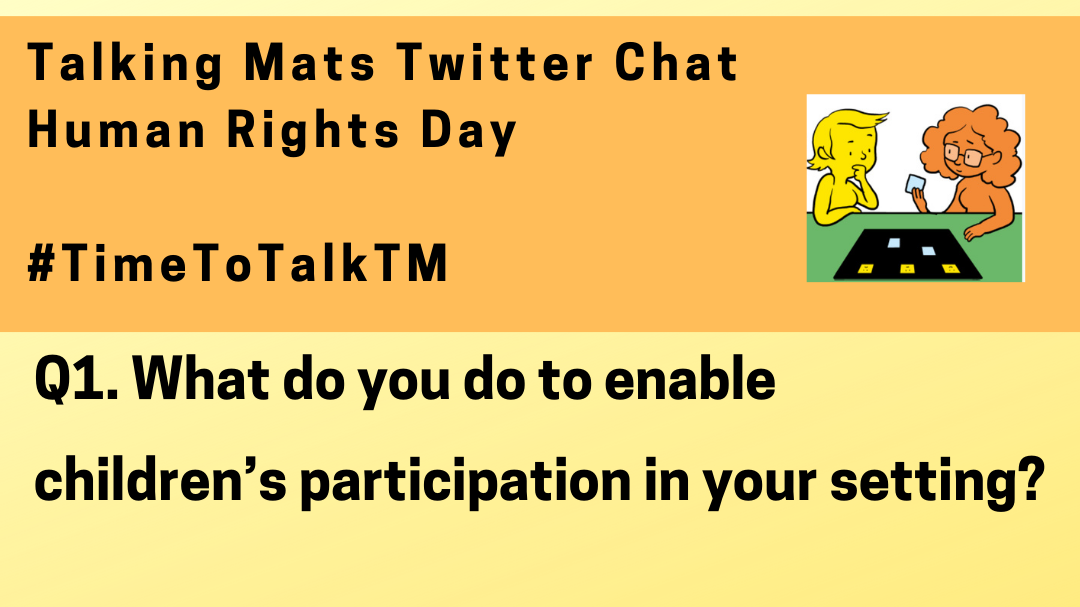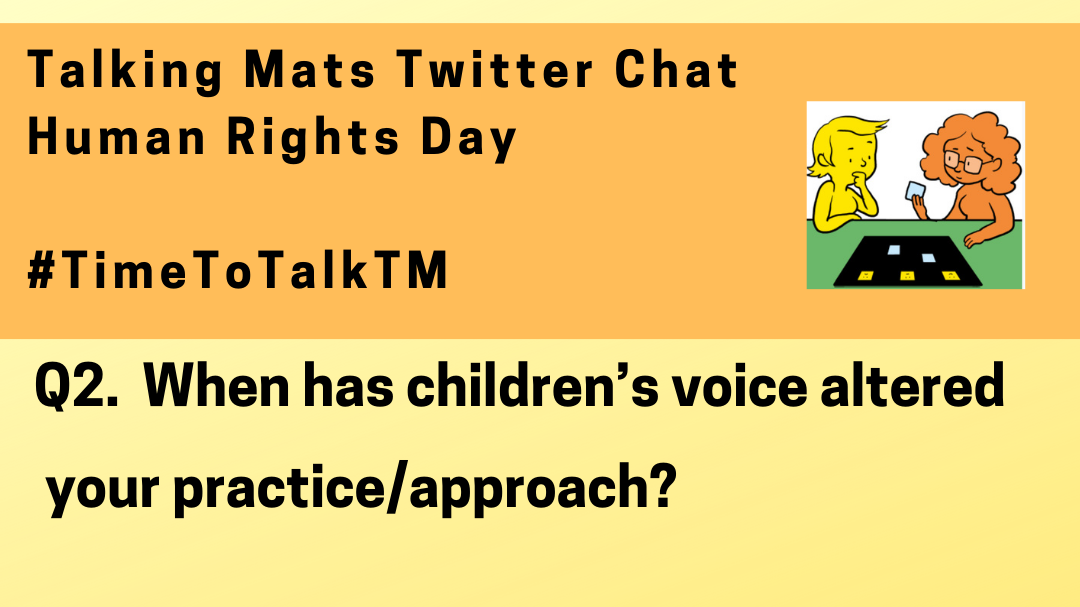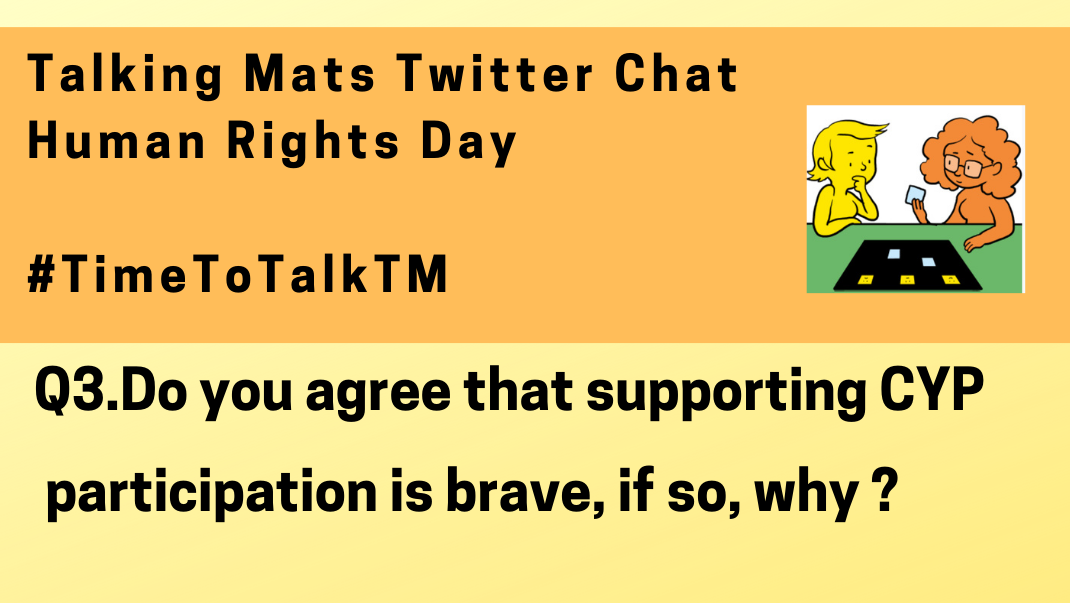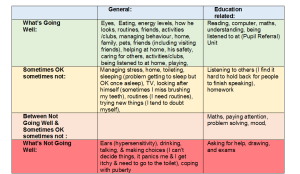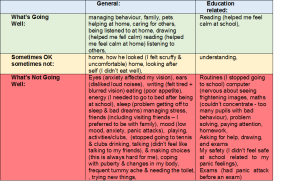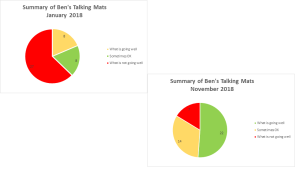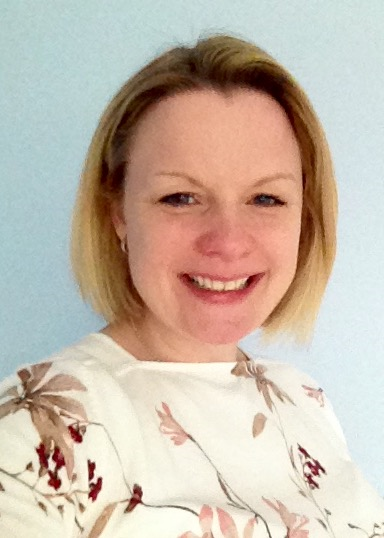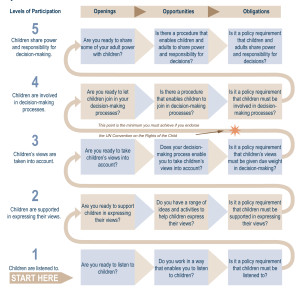We are looking forward to our second Talking Mats Twitter chat on Thursday 10/12/20 7.30 – 8.30pm.
Join us to discuss and celebrate our new report ‘Can Scotland Be Brave’, which has a specific focus on children and young people’s participation. Find out more about the report here https://www.talkingmats.com/new-report-to-launch-10th-dec/
The report will be launched by the Scottish Government on the same day, to coincide with Human Rights Day 2020.
Here are the questions we will be asking:
Grab a cuppa – or better still, a mulled wine and mince pie! – and join us to share experiences and ideas.
Remember to use the hashtag #TimeToTalkTM on all your posts!
We are all looking forward to celebrating Talking Mats is 21 on the 15th August
The morning is aimed at people who are experienced Talking Mats practitioners and will extend thinking and Talking Mats practice. There are an interesting range of parallel sessions to choose from. Each participant will get to choose three topics to attend.
- Talking Mats as a Thinking Tool
- Embedding Talking Mats in Schools
- Talking Mats in Forensic Settings
- Talking Mats in End of Life Care
- My experience of using Talking Mats as a parent
- Talking Mats and Positive behaviour Support
- Talking Mats and Supported Decision- Making
- Empowering people with Learning Disabilities to be Talking Mats Listeners and Trainers
- Talking Mats and Children’s Mental Health
The afternoon is more informal and there will be an opportunity to engage with some of our partners – see how they use Talking Mats and try things out . There will be posters on the use of Talking Mats in lots of different places and for a wide range of applications.
Plus there will be lunch, cake and a few bubbles !
Thanks to funding from NHS Forth Valley endowment committee the event is free but you do need to book your space https://www.eventbrite.co.uk/e/talking-mats-is-21-tickets-62362171935
You can come to the morning only, afternoon only or come for the whole day.
If you can’t come to our event watch out for out blogs and social media celebrating the reach of Talking Mats for 21 days before the 15th of August .Please join in with your contributions using the hashtag #TMis21. For 21 days after our event we will be having a special Birthday offer! Watch this space, more to follow …….
Many thanks to Tina Wood, Occupational Therapist at Therapy In Motion, for this great example of how Talking Mats can be used to explore thoughts and feelings both in present-day and in retrospect, to evidence positive outcomes from a change in educational placement. Tina’s use of colour coding and pie charts really helps to illustrate this.
Tina attended our Talking Mats Foundation training back in September 2016 and since then she has been using Talking Mats regularly in her work as an Independent Occupational Therapist.
In this example, Tina has used Talking Mats to enable Ben (name changed for anonymity, age 12½ years) to share his thoughts and feelings using the Talking Mats ‘Consulting Children and Young People’ resource packs – focusing on the topics ‘My Body and Skills’ and ‘What I do and Support’.
At the time of this Talking Mat, Ben had been accessing a new placement at a Pupil Referral Unit for the past 11 months (click on the picture below to see a clearer version).
As there was clearly a difference in how Ben felt things were going when he was attending his previous school, Tina decided to ask him to do a retrospective Talking Mat of how things were going for him 11 months ago in January 2018, when he started to feel “unwell”.
This enabled comparison with how he feels now in the “safe setting” of the Pupil Referral unit (click on picture to see a clearer version).
Tina then compiled the information from the above tables into pie charts, enabling a clear visual comparison between the two times/situations (click on picture to see a clearer version):
As can be seen from these charts, there had been a huge change in Ben’s perception of how he is coping with life in general and school in particular.
Tina recommended that this information needs to be considered along with the rest of Ben’s sensory needs (as reported in her full OT report) when deciding on what is the best educational setting for him after leaving the pupil referral unit.
We love this use of colour coding and pie charts to illustrate the information from Ben’s Talking Mats – to really ensure that Ben’s feelings and thoughts are seen and heard.
If you would like to know more about accessing Talking Mats training – available across the UK and Ireland as well as online – please take a look here: https://www.talkingmats.com/training/
If you have any examples of how you report/share information about completed Talking Mats we would be interested to hear about it! Just email laura@talkingmats.com
We are delighted to introduce Laura Holmes our first Regional Talking Mats Associate. She is joining the Talking Mats team and will be working in the North West of England. I will let Laura introduce herself:-
” Hi, I am a Speech and Language Therapist working in Stockport, Cheshire. I am delighted to be joining Talking Mats as the first Regional Associate, covering the North West of England. I work 1 day a week, term-time only for Talking Mats, as well as 3 days a week for the NHS. I am excited about developing awareness, understanding and use of Talking Mats across the area, within the context of the SEND reforms in particular, over the next few months. I feel Talking Mats is a very effective way of truly capturing the voices of the children and young people I work with. The Talking Mats approach also links well with the use of Therapy Outcome Measures, which I am currently trialling with my caseload. I am looking forward to sharing my knowledge and experiences to facilitate wider use of this versatile approach across the North West region.”
It is great to have Laura working with us to build on some of the excellent work being done already in the North West. Two examples of best practice are in Wigan where Talking Mats are used to increase child participation and more recently in Salford. Children’s services in Salford NHS foundation trust are committed to seeking the views of children and young people about how they feel about their health appointments. They have finished piloting their own Talking Mats set and the revised set has just been sent to the printers – it looks great.
We are running a training course in Liverpool on the 21st April and we would love to meet more of you from the North West.
What works well when implementing Talking Mats?
Our last blog highlight how the Wigan Pathfinder Project selected Talking Mats from a range of tools to consult with pupils who have Education, Health and Care plans (EHCP) . They reported that Talking mats provided :
- An objective, neutral space – a thinking tool- ‘Children and young people are able to consider their priorities when setting targets’.
- Opportunities for change – ‘Children and young people are able to make changes to their initial thoughts and have time to decide and reconsider options’.
- A truly person centred approach
- It was fun!
Additional factors they commented on which worked well when consulting with pupils about decision making and goal setting were:
- Good liaison with parents and staff who know the child well before the session
- Adapting the length of the session to the child’s needs
- Ensuring a suitable room without too many distractions
- Using the teaching scale
- Putting the child’s name on the mat
- Placing all topics in one envelope for easy access
- Allowing time to sort symbols and discard irrelevant ones.
- Reducing the number of symbols used depending on the child’s needs
- Changing the top scale symbols to support the child’s understanding where necessary
- Keeping a verbal record where appropriate
- Working in pairs whilst learning the approach
- Using the effectiveness coding framework (all case studies scored above 75%, therefore considered effective using this measure)
The Talking mats training focuses on teaching how to establish a consistent and appropriate top scale, maintaining a clear topic and using the effectiveness framework. It also presents a model for thinking about who can and cannot use the mat and for what types of questions and discussions
We are grateful to Emma Atkiss, one of our accredited trainers for this interesting report.
The purpose of The Voice of the Child pilot project carried out by the Wigan Pathfinder team was to obtain pupil views using a viable tool. The team selected Talking Mats as a framework to support pupils to express their views in decisions regarding their lives. They were working on the principle that engaging with the young person and his/her family would lead to better outcomes
The project team considered that Talking Mats met the 5 criteria of Shier’s model of participation (2001)
- Children are listened to.
- Children are supported in expressing their views.
- Children’s views are taken into account.
- Children are involved in the decision-making processes.
- Children share power and responsibility for decision-making.
Click on diagram to enlarge.
The pupils in the pilot ranged from 7 to 17 years with a range of disabilities. During the pupil interviews the team found that the Talking Mats Health and Well being resource provided a practical framework for decision making and target setting
Talking mats provided :
- An objective, neutral space – a thinking tool- ‘Children and young people are able to consider their priorities when setting targets’.
- Opportunities for change – ‘Children and young people are able to make changes to their initial thoughts and have time to decide and reconsider options’.
- A truly person centred approach
- It was fun!
For example : A seven year old child with Autistic Spectrum Disorder identified both her cognitive strengths and areas for development using the Learning and Thinking domain. She provided feedback regarding her difficulty in attending when faced with too much information or choice and also her strength in planning skills. Thinking skills targets and interventions can be developed using this information as a starting point.
Their report states that the information gained from Talking Mats can be used, as part of the Education Health and Care planning and review cycle, to inform both decision-making and goal setting for children and young people i.e. It identifies strengths; It identifies areas to develop; It identifies the child / young person’s response to a range of experiences; It informs day-to-day decision-making ; It informs both targets and interventions for Individual Education Plans and it supports transition planning.
Ref : Engaging the voice of the child / young person at an individual level – Emma Atkiss,Senior Educational Psychologist and Caroline Gomez, Educational Psychologist, Wigan council
Sophie Mitchell SLT describes how she supported her students to develop their EHC Plans with the Talking Mats app .
In September 2014 our team and I were asked to facilitate the production of Education and Health Care plans for the Year 14 students at the Secondary Special School (for adolescents with complex, profound and multiple learning difficulties) where we are based. As Speech and Language therapists we were asked to work with the students to gain their view on what they would like to be detailed in their plan and also what their aspirations were for their future. We wanted to ensure the production of these plans were as client centred as possible so therefore decided to use the Talking Mats App on the Ipad using the Health and Wellbeing resource. This resource proved invaluable when working with our students. Not only were our students highly motivated to participate in the sessions due to the Ipad being used, talking mats empowered them to make meaningful decisions about their future, communicate any areas where they would like further support and discuss likes and dislikes. The impact on our students became clear when working with one 19 year old student. Although he did not have any spontaneous expressive language and would only echo things said by others, during a Talking Mats sessions when talking about his likes and dislikes, he appeared to be placing most items under ‘dislike’. As the session went on the student started to appear agitated, then started pointing towards ‘like’ although no symbol was presented. Suddenly the student said ‘Garden’, still pointing towards the ‘like’. When presented with a gardening symbol he soon placed this under ‘like’. This information was then presented in his plan and his college were instructed to explore opportunities for this student to develop his gardening skills. For all students this information was then used to not only create their Education and Health Care plan but also expand and explore areas they were highly motivated by while still at School and also identify possible work placements for the future. Furthermore the School invested in Talking mats training to ensure this approach is used throughout each academic year and school staff are skilled to use Talking Mats as each student starts their assessment for their Education and Health Care plan.
We would like to thank Sophie who is from Sandwell and West Birmingham NHS trust for such a great example of how to use the app in EHC Planning . If you are interested in purchasing the digital Talking Mat then please phone the office 01786479511. We are just changing the purchasing model from subscription to one off sale so its temporarily removed from the web site.
Thanks to Anita Devi,Education Consultant, for her helpful contribution to this blog.
The implementation of the recent SEND reforms in England requires interdisciplinary teamwork. Integrated assessments will now be carried out in cooperation with the young person and the parents. Capturing the child’s own perspective and recording their views, interests and aspirations is now a statutory requirement. The principles of the SEND Code of Practice state that practitioners should encourage the child or young person, and the child’s parents to participate as fully as possible in the decisions affecting their lives and use a common language to shape educational and other outcomes.
Talking Mats has produced a practical and creative resource – “Consulting Children & Young People” that helps practitioners to ensure that they take account of the SEND Principles at all stages of the assessment process and development of the EHC Plan.
We recognised the need to develop a tool that would give a holistic picture of how a child or young person feels about their lives at home, at school and in their communities. Having a visual framework means that there’s more time for reflection. You can help young people to see their personal strengths and abilities and take time to consider what their problem areas are. Talking Mats gives greater choice and control about what kind of intervention is required to support them.
Communication is a two way process and the role of the facilitator is crucial. Talking Mats provides training at the following levels:
- Awareness – an introduction to the Talking Mats framework and the development of the CCYP resource.
- Enhanced – a whole day training to equip practitioners to use Talking Mats
- Specialist – In depth training which allows the practitioner to train others in their organisation.
(as stipulated on page 58 of The 2014 SEND Code of Practice for England)
Why not sign up for one of our training courses and learn more about –
Improving the quality of your engagement
Creating a visual framework for consultation
A child centred approach to joint decision making.
Read Part 2 of this blog next week.
 Online training login
Online training login 

